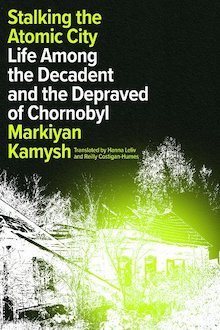 From Astra Publishing House | Stalking the Atomic City: Life Among the Decadent and the Depraved of Chornobyl by Markiyan Kamysh, translated from the Ukranian by Reilly Costigan-Humes and Hanna Leliv | Nonfiction | 160 pages | ISBN 9781662601279 | US$22.00
From Astra Publishing House | Stalking the Atomic City: Life Among the Decadent and the Depraved of Chornobyl by Markiyan Kamysh, translated from the Ukranian by Reilly Costigan-Humes and Hanna Leliv | Nonfiction | 160 pages | ISBN 9781662601279 | US$22.00
What the publisher says: “In Stalking the Atomic City, Kamysh tells us about thieves who hide in the abandoned buildings, the policemen who chase them, and the romantic utopists who have built families here, even as deadly toxic waste lingers in the buildings, playgrounds, and streams.”
What Publishers Weekly says: “Mixing travelogue and reportage, Kamysh, whose father helped clear the site of contaminated debris, finds a stark metaphor for post-Soviet depravity in the derelict world he explores. He describes hiking 20 miles through waist-deep snow to climb 500-foot radar antennae; sleeping in an abandoned building near the rotting corpse of a wolf; being ambushed by police; and his ‘radiation fetishism’ for contaminated graphite rods and ‘still glowing’ liquidator’s helmets.”
What I say: Every once in a while, I’ll read something about tourists venturing into the area around Chornobyl for a day or two, and the effect is somewhat dizzying. Markiyan Kamysh’s new book is infinitely more so—this is an intimate, lived-in account of a ruined landscape and the people who find themselves drawn to it. It’s a haunting, immersive read.
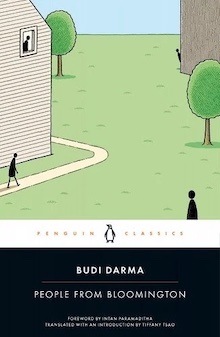 From Penguin Classics | People from Bloomington by Budi Darma, translated from the Indonesian by Tiffany Tsao | Fiction | 208 pages | ISBN 9780143136606 | US$14.00
From Penguin Classics | People from Bloomington by Budi Darma, translated from the Indonesian by Tiffany Tsao | Fiction | 208 pages | ISBN 9780143136606 | US$14.00
What the publisher says: “In these seven stories of People from Bloomington, our peculiar narrators find themselves in the most peculiar of circumstances and encounter the most peculiar of people. Set in Bloomington, Indiana, where the author lived as a graduate student in the 1970s, this is far from the idyllic portrait of small-town America.”
What Asian Review of Books says: “The author lists as influences authors as varied as Jane Austen and Franz Kafka, but he also seems to be channeling Roald Dahl, another writer whose short stories feature vaguely off-kilter protagonists in unhealthy (literally or figuratively) situations, yielding a similar sense of unease and discomfort that remains behind after the stories conclude.”
What I say: When I picked up People from Bloomington, I expected carefully wrought character studies and thoughtfully drawn characters. What I wasn’t expecting was how weird (or, perhaps, Weird) this book could get. Darma zeroes in on his characters’ obsessions and violent impulses, with the end result playing out something like—to invoke a completely different art form—Kieślowski’s Decalogue run through an A24 horror filter.
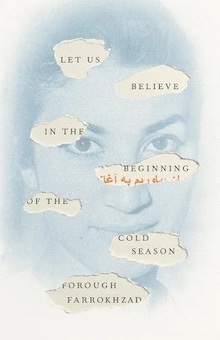 From New Directions | Let Us Believe in the Beginning of the Cold Season by Forough Farrokhzad, translated from the Persian by Elizabeth T. Gray, Jr. | Poetry | 128 pages | ISBN 9780811231657 | US$16.95
From New Directions | Let Us Believe in the Beginning of the Cold Season by Forough Farrokhzad, translated from the Persian by Elizabeth T. Gray, Jr. | Poetry | 128 pages | ISBN 9780811231657 | US$16.95
What the publisher says: “This thoughtfully curated, deftly translated selection of Farrokhzad’s poems includes work from her whole writing life, early to late. Readers will thoroughly treasure this expansive poet of the quotidian; of longing, loss, and desire; of classical reinvention; of lexical variation and sonic beauty; of terrifying wisdom, hope, and grief.”
What 4Columns says: “Farrokhzad has a mystical sensibility, which is a challenge for the translator, who must strike a balance between the poem’s worldly material and spiritual tone. It is a mark of their success that Gray’s renditions pull the reader along as they attain liftoff.”
What I say: This collection of Farrokhzad’s poetry, spanning the breadth of her life, offers a fantastic look at the violence of men and the intimacy that can occur between two people. It’s tactile and visceral when it needs to be, with a compelling amount of the mystical to boot: “I speak from the limit of night / I speak from the limit of darkness / and of the limit of night.”
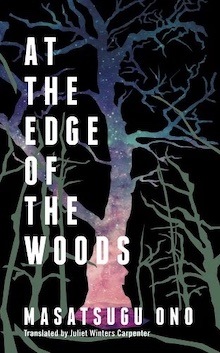 From Two Lines Press | At the Edge of the Woods by Masatsugu Ono, translated from the Japanese by Juliet Winters Carpenter | Fiction | 184 pages | ISBN 9781949641288 | US$16.95
From Two Lines Press | At the Edge of the Woods by Masatsugu Ono, translated from the Japanese by Juliet Winters Carpenter | Fiction | 184 pages | ISBN 9781949641288 | US$16.95
What the publisher says: “An allegory for alienation and climate catastrophe unlike any other, At the Edge of the Woods is a psychological tale where myth and fantasy are not the dominion of childhood innocence but the poison fruit borne of the paranoia and violence of contemporary life.”
What Foreword Reviews says: “A chill permeates the book, in which the lines between reality and illusion are blurred. Television news programs report floods and endless lines of refugees; the lines also appear on nearby roads, or seem to. Nature has gone haywire. The woods are full of menace and danger, shapeshifting and alive. The few people whom the family sees are hostile and grotesque.”
What I say: What happens when a consensus reality begins to break down? At the Edge of the Woods is about a family living in isolation, who are then further divided over the impending arrival of a baby. What makes this book memorable isn’t just the dissolution of bonds between family members but also the way in which a logical reality seems to come untethered: what’s with the old woman who befriends one of the family’s children? Are they actually surrounded by creatures from folklore? The levels of delirium advance meticulously toward this novel’s denouement, and I am very much here for it.
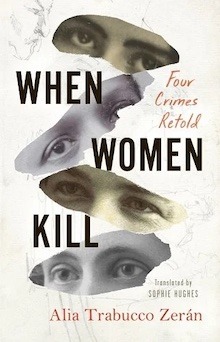 From Coffee House Press | When Women Kill: Four Crimes Retold by Alia Trabucco Zerán, translated from the Spanish by Sophie Hughes | Nonfiction | 248 pages | ISBN 9781566896337 | US$16.95
From Coffee House Press | When Women Kill: Four Crimes Retold by Alia Trabucco Zerán, translated from the Spanish by Sophie Hughes | Nonfiction | 248 pages | ISBN 9781566896337 | US$16.95
What the publisher says: “When Women Kill: Four Crimes Retold analyzes four homicides carried out by Chilean women over the course of the twentieth century. Drawing on her training as a lawyer, Alia Trabucco Zerán offers a nuanced close reading of their lives and crimes, foregoing sensationalism in order to dissect how all four were both perpetrators of violent acts and victims of another, more insidious kind of violence.”
What Asymptote says: “The Remainder sealed its author as one of Chile’s most recognized and poignant debut novelists, and central to its story is the same uneasiness of forgetting that pervades When Women Kill; what is true, in a lawful sense, is curled and uncurled in this text, making it one of the more incisive intersectional feminist analyses of myth and murder.”
What I say: Alia Trabucco Zerán’s When Women Kill takes on an ambitious series of goals—to recount the stories of four killings, to find connections between all of them, and to show how they relate to a societal progression in Chile. To her credit, she succeeds—and the resulting work is one that true crime buffs and fans of cultural history can appreciate in equal measure.
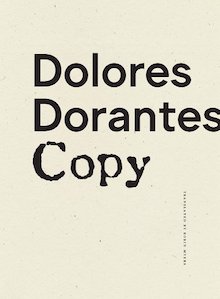 From Wave Books | Copy by Dolores Dorantes, translated from the Spanish by Robin Myers | Poetry | 88 pages | ISBN 9781950268566 | US$18.00
From Wave Books | Copy by Dolores Dorantes, translated from the Spanish by Robin Myers | Poetry | 88 pages | ISBN 9781950268566 | US$18.00
What the publisher says: “Through deconstructed dictionary entries and powerfully syncopated, recursive texts, Copy is a prose poem sequence that insinuates an experience of violent removal: a person’s disappearance from a country, from normal life, and forcible reintegration into a new social and existential configuration.”
What Poetry says: “What makes this work at times inaccessible is also what makes it profound. The writing is elusive and inconclusive, provocative, even brutal. More than anything, it’s enigmatic: Is the above a liberatory invitation? A demanding ultimatum? A delusional mandate? Ultimately, the text asks us to buzz in this ambiguity, in its relentless interrogation of identity and self . . .”
What I say: Copy is a vertiginous work that defies easy classification. At times, Dorantes’s staccato phrasing gives things a harrowing energy: “Nature. This inner emptiness. It tends to escape others’ perception. Because you know how to manipulate your behavior. To mold oneself. In fulfillment of duty.” The references to interrogations and checkpoints scattered throughout suggest a wider, more menacing world—and turn that energy into something like out-and-out propulsion.
Copyright © 2022 Tobias Carroll. All rights reserved.
Looking for more reading suggestions? Check out Tobias Carroll’s recommendations from last month.
Disclosure: Words Without Borders is an affiliate of Bookshop.org and will earn a commission if you use the links above to make a purchase.










